MGT201 Cross Cultural Report: Contrasting Iran and Mexico's Cultures
VerifiedAdded on 2023/06/16
|6
|1296
|321
Report
AI Summary
This report provides a comparative analysis of Iranian and Mexican cultures through the lens of Hall's High-Low Context theory, highlighting differences in communication styles, value systems, and societal norms. Iran is characterized as a high-context culture, emphasizing long-term relationships, implicit communication, and the importance of non-verbal cues, influenced by Shia Islam and Persian traditions. In contrast, Mexico is presented as a low-context culture, prioritizing explicit communication, short-term relationships, and adherence to rules, with a task-centered approach. The report also examines egalitarian values, family culture, and socio-political influences in both countries, referencing academic sources to support the analysis. Desklib provides access to similar reports and resources for students.
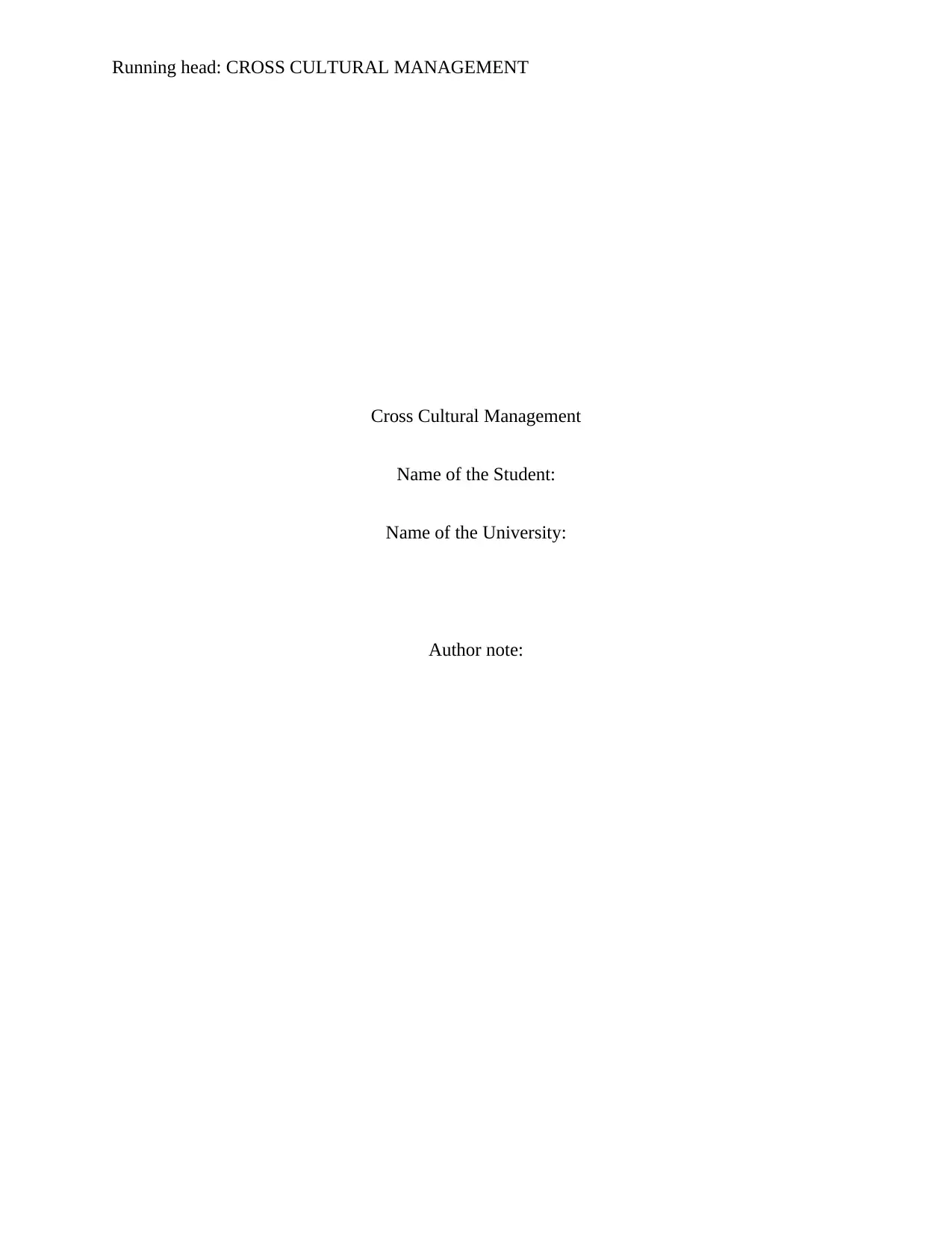
Running head: CROSS CULTURAL MANAGEMENT
Cross Cultural Management
Name of the Student:
Name of the University:
Author note:
Cross Cultural Management
Name of the Student:
Name of the University:
Author note:
Paraphrase This Document
Need a fresh take? Get an instant paraphrase of this document with our AI Paraphraser
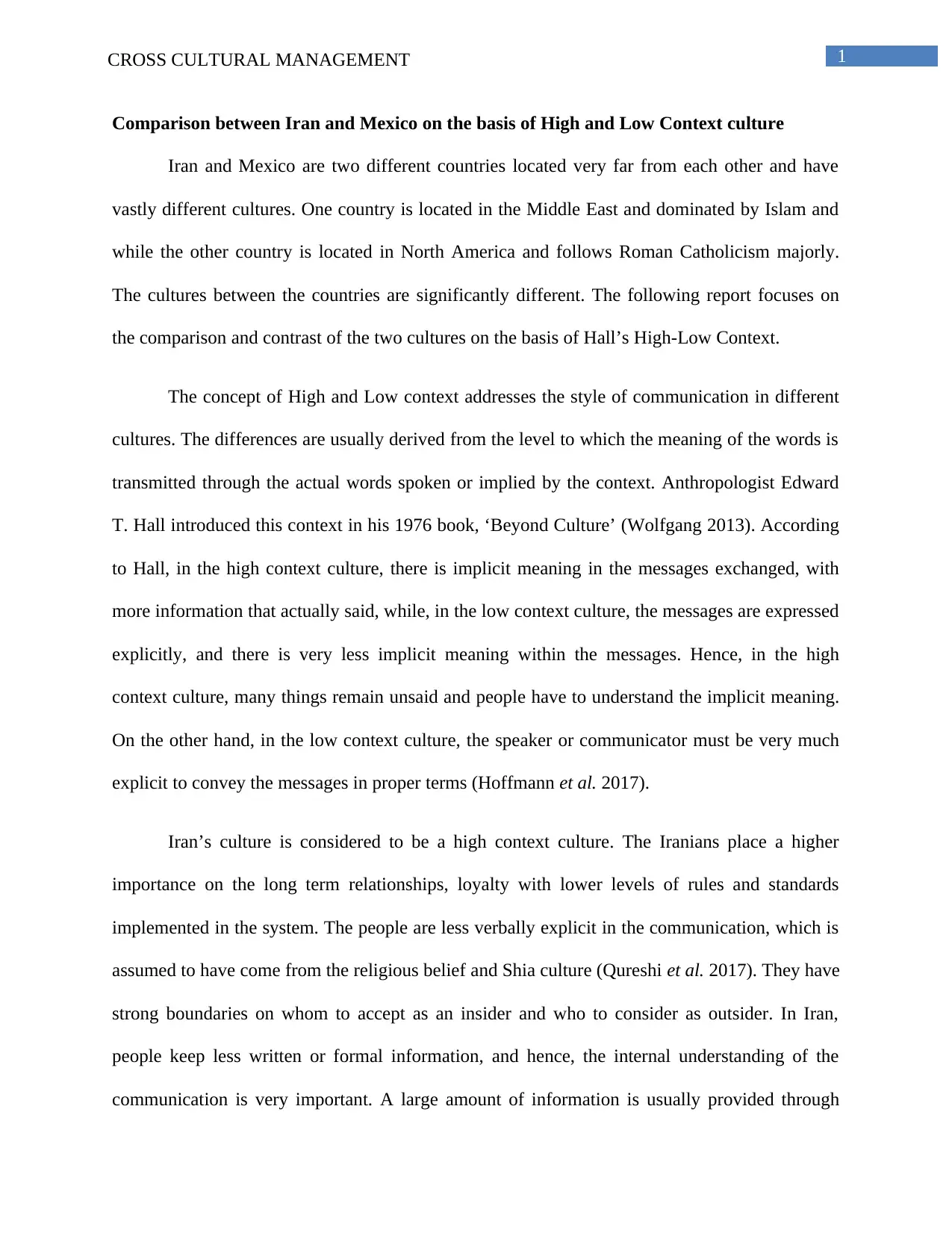
1CROSS CULTURAL MANAGEMENT
Comparison between Iran and Mexico on the basis of High and Low Context culture
Iran and Mexico are two different countries located very far from each other and have
vastly different cultures. One country is located in the Middle East and dominated by Islam and
while the other country is located in North America and follows Roman Catholicism majorly.
The cultures between the countries are significantly different. The following report focuses on
the comparison and contrast of the two cultures on the basis of Hall’s High-Low Context.
The concept of High and Low context addresses the style of communication in different
cultures. The differences are usually derived from the level to which the meaning of the words is
transmitted through the actual words spoken or implied by the context. Anthropologist Edward
T. Hall introduced this context in his 1976 book, ‘Beyond Culture’ (Wolfgang 2013). According
to Hall, in the high context culture, there is implicit meaning in the messages exchanged, with
more information that actually said, while, in the low context culture, the messages are expressed
explicitly, and there is very less implicit meaning within the messages. Hence, in the high
context culture, many things remain unsaid and people have to understand the implicit meaning.
On the other hand, in the low context culture, the speaker or communicator must be very much
explicit to convey the messages in proper terms (Hoffmann et al. 2017).
Iran’s culture is considered to be a high context culture. The Iranians place a higher
importance on the long term relationships, loyalty with lower levels of rules and standards
implemented in the system. The people are less verbally explicit in the communication, which is
assumed to have come from the religious belief and Shia culture (Qureshi et al. 2017). They have
strong boundaries on whom to accept as an insider and who to consider as outsider. In Iran,
people keep less written or formal information, and hence, the internal understanding of the
communication is very important. A large amount of information is usually provided through
Comparison between Iran and Mexico on the basis of High and Low Context culture
Iran and Mexico are two different countries located very far from each other and have
vastly different cultures. One country is located in the Middle East and dominated by Islam and
while the other country is located in North America and follows Roman Catholicism majorly.
The cultures between the countries are significantly different. The following report focuses on
the comparison and contrast of the two cultures on the basis of Hall’s High-Low Context.
The concept of High and Low context addresses the style of communication in different
cultures. The differences are usually derived from the level to which the meaning of the words is
transmitted through the actual words spoken or implied by the context. Anthropologist Edward
T. Hall introduced this context in his 1976 book, ‘Beyond Culture’ (Wolfgang 2013). According
to Hall, in the high context culture, there is implicit meaning in the messages exchanged, with
more information that actually said, while, in the low context culture, the messages are expressed
explicitly, and there is very less implicit meaning within the messages. Hence, in the high
context culture, many things remain unsaid and people have to understand the implicit meaning.
On the other hand, in the low context culture, the speaker or communicator must be very much
explicit to convey the messages in proper terms (Hoffmann et al. 2017).
Iran’s culture is considered to be a high context culture. The Iranians place a higher
importance on the long term relationships, loyalty with lower levels of rules and standards
implemented in the system. The people are less verbally explicit in the communication, which is
assumed to have come from the religious belief and Shia culture (Qureshi et al. 2017). They have
strong boundaries on whom to accept as an insider and who to consider as outsider. In Iran,
people keep less written or formal information, and hence, the internal understanding of the
communication is very important. A large amount of information is usually provided through
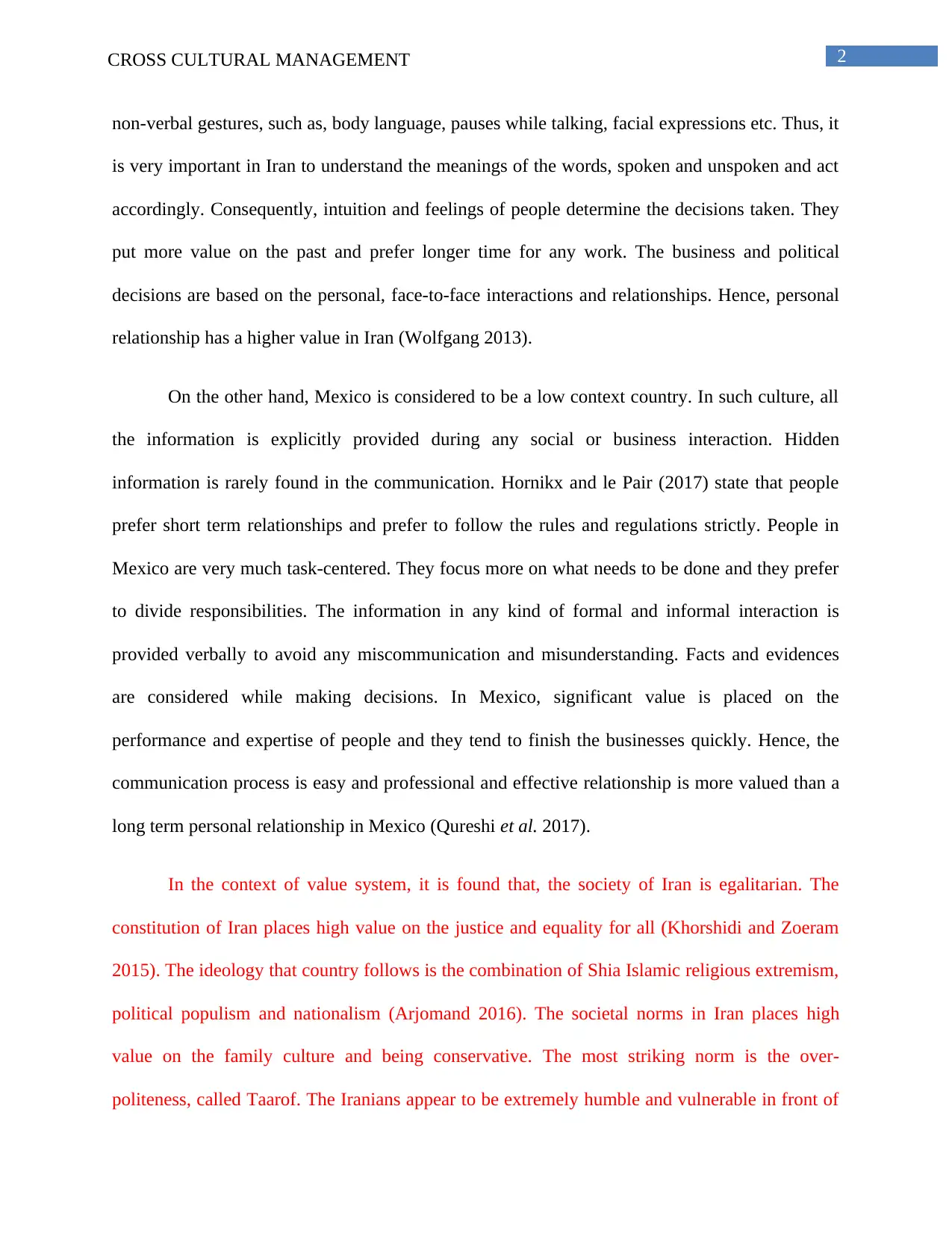
2CROSS CULTURAL MANAGEMENT
non-verbal gestures, such as, body language, pauses while talking, facial expressions etc. Thus, it
is very important in Iran to understand the meanings of the words, spoken and unspoken and act
accordingly. Consequently, intuition and feelings of people determine the decisions taken. They
put more value on the past and prefer longer time for any work. The business and political
decisions are based on the personal, face-to-face interactions and relationships. Hence, personal
relationship has a higher value in Iran (Wolfgang 2013).
On the other hand, Mexico is considered to be a low context country. In such culture, all
the information is explicitly provided during any social or business interaction. Hidden
information is rarely found in the communication. Hornikx and le Pair (2017) state that people
prefer short term relationships and prefer to follow the rules and regulations strictly. People in
Mexico are very much task-centered. They focus more on what needs to be done and they prefer
to divide responsibilities. The information in any kind of formal and informal interaction is
provided verbally to avoid any miscommunication and misunderstanding. Facts and evidences
are considered while making decisions. In Mexico, significant value is placed on the
performance and expertise of people and they tend to finish the businesses quickly. Hence, the
communication process is easy and professional and effective relationship is more valued than a
long term personal relationship in Mexico (Qureshi et al. 2017).
In the context of value system, it is found that, the society of Iran is egalitarian. The
constitution of Iran places high value on the justice and equality for all (Khorshidi and Zoeram
2015). The ideology that country follows is the combination of Shia Islamic religious extremism,
political populism and nationalism (Arjomand 2016). The societal norms in Iran places high
value on the family culture and being conservative. The most striking norm is the over-
politeness, called Taarof. The Iranians appear to be extremely humble and vulnerable in front of
non-verbal gestures, such as, body language, pauses while talking, facial expressions etc. Thus, it
is very important in Iran to understand the meanings of the words, spoken and unspoken and act
accordingly. Consequently, intuition and feelings of people determine the decisions taken. They
put more value on the past and prefer longer time for any work. The business and political
decisions are based on the personal, face-to-face interactions and relationships. Hence, personal
relationship has a higher value in Iran (Wolfgang 2013).
On the other hand, Mexico is considered to be a low context country. In such culture, all
the information is explicitly provided during any social or business interaction. Hidden
information is rarely found in the communication. Hornikx and le Pair (2017) state that people
prefer short term relationships and prefer to follow the rules and regulations strictly. People in
Mexico are very much task-centered. They focus more on what needs to be done and they prefer
to divide responsibilities. The information in any kind of formal and informal interaction is
provided verbally to avoid any miscommunication and misunderstanding. Facts and evidences
are considered while making decisions. In Mexico, significant value is placed on the
performance and expertise of people and they tend to finish the businesses quickly. Hence, the
communication process is easy and professional and effective relationship is more valued than a
long term personal relationship in Mexico (Qureshi et al. 2017).
In the context of value system, it is found that, the society of Iran is egalitarian. The
constitution of Iran places high value on the justice and equality for all (Khorshidi and Zoeram
2015). The ideology that country follows is the combination of Shia Islamic religious extremism,
political populism and nationalism (Arjomand 2016). The societal norms in Iran places high
value on the family culture and being conservative. The most striking norm is the over-
politeness, called Taarof. The Iranians appear to be extremely humble and vulnerable in front of
⊘ This is a preview!⊘
Do you want full access?
Subscribe today to unlock all pages.

Trusted by 1+ million students worldwide
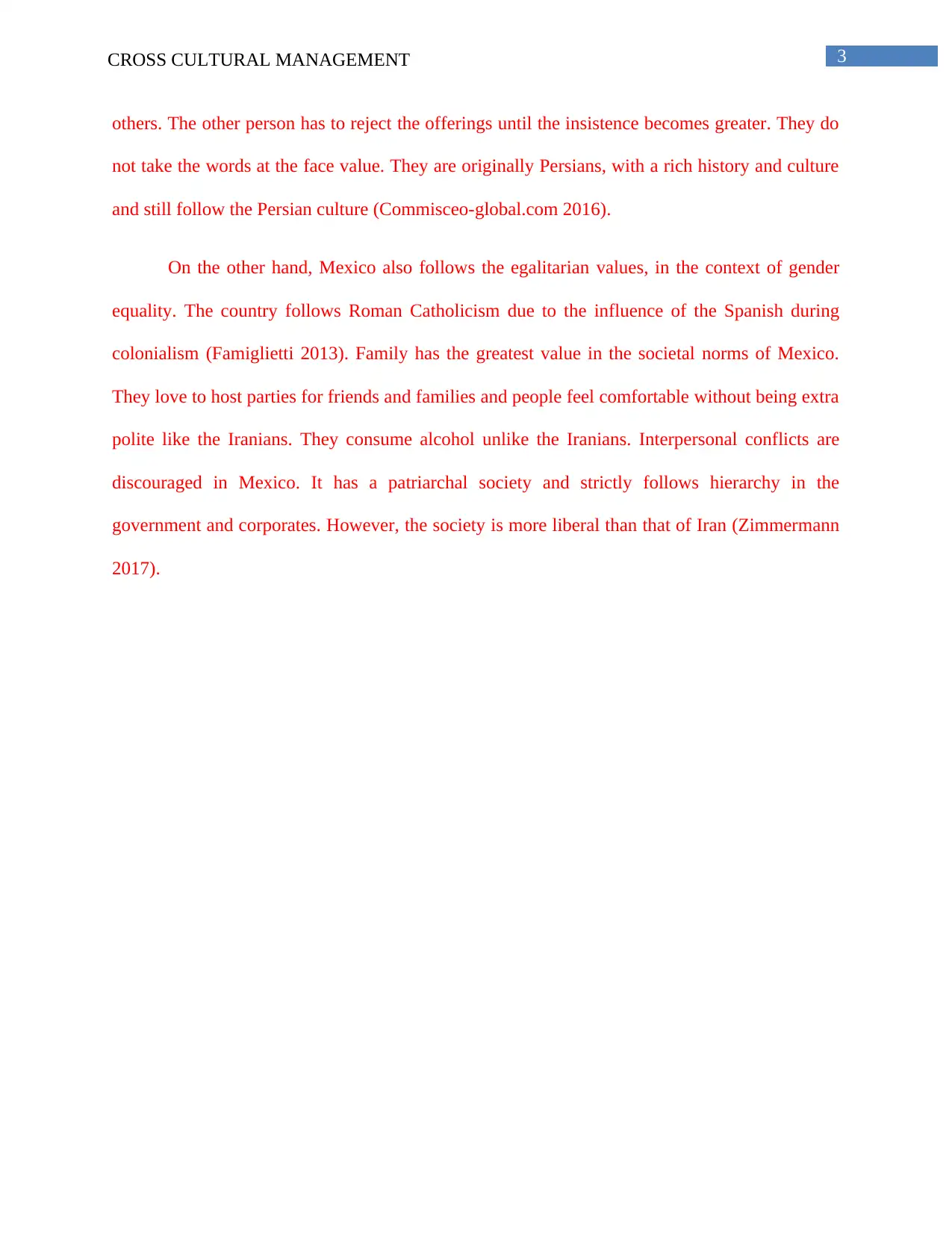
3CROSS CULTURAL MANAGEMENT
others. The other person has to reject the offerings until the insistence becomes greater. They do
not take the words at the face value. They are originally Persians, with a rich history and culture
and still follow the Persian culture (Commisceo-global.com 2016).
On the other hand, Mexico also follows the egalitarian values, in the context of gender
equality. The country follows Roman Catholicism due to the influence of the Spanish during
colonialism (Famiglietti 2013). Family has the greatest value in the societal norms of Mexico.
They love to host parties for friends and families and people feel comfortable without being extra
polite like the Iranians. They consume alcohol unlike the Iranians. Interpersonal conflicts are
discouraged in Mexico. It has a patriarchal society and strictly follows hierarchy in the
government and corporates. However, the society is more liberal than that of Iran (Zimmermann
2017).
others. The other person has to reject the offerings until the insistence becomes greater. They do
not take the words at the face value. They are originally Persians, with a rich history and culture
and still follow the Persian culture (Commisceo-global.com 2016).
On the other hand, Mexico also follows the egalitarian values, in the context of gender
equality. The country follows Roman Catholicism due to the influence of the Spanish during
colonialism (Famiglietti 2013). Family has the greatest value in the societal norms of Mexico.
They love to host parties for friends and families and people feel comfortable without being extra
polite like the Iranians. They consume alcohol unlike the Iranians. Interpersonal conflicts are
discouraged in Mexico. It has a patriarchal society and strictly follows hierarchy in the
government and corporates. However, the society is more liberal than that of Iran (Zimmermann
2017).
Paraphrase This Document
Need a fresh take? Get an instant paraphrase of this document with our AI Paraphraser
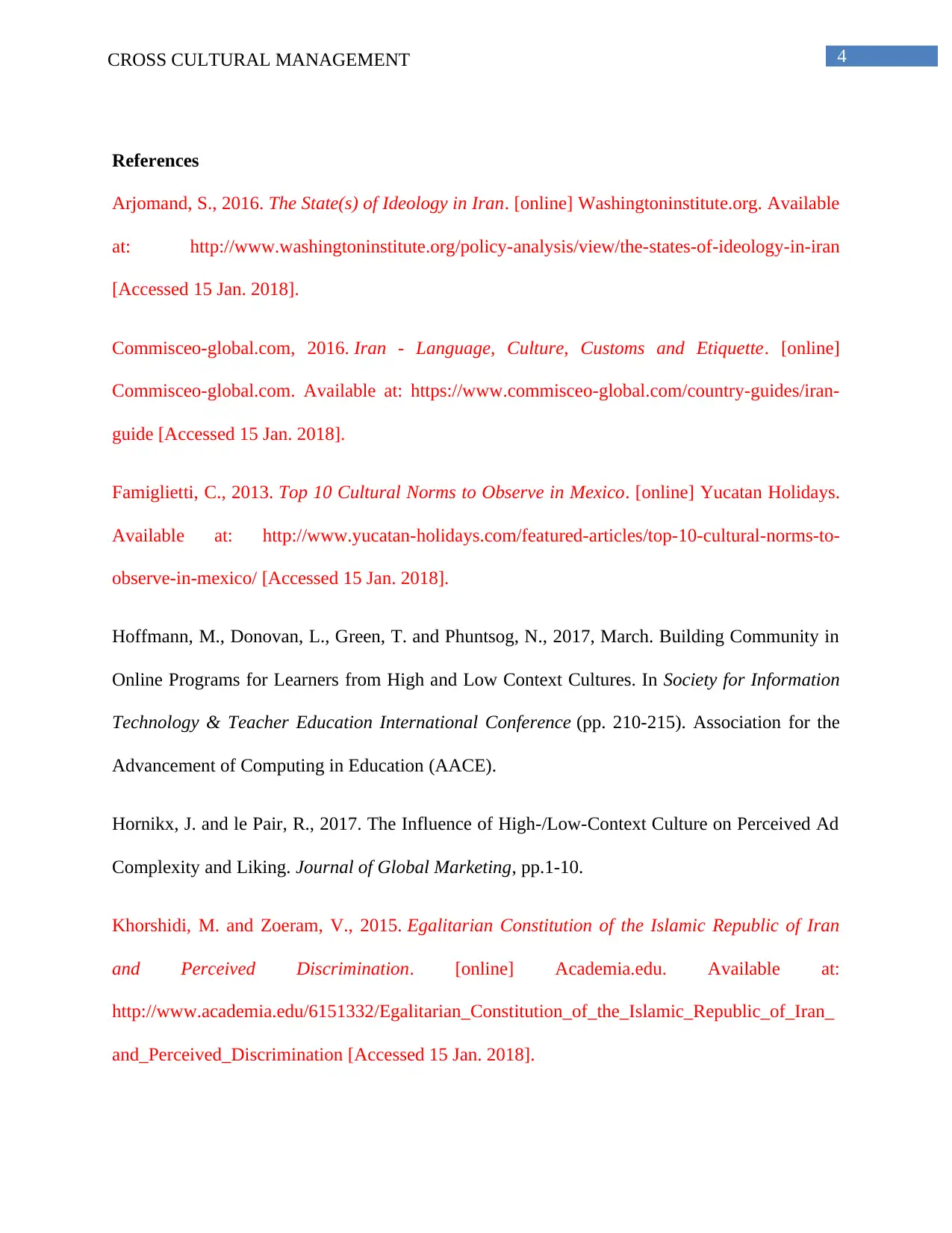
4CROSS CULTURAL MANAGEMENT
References
Arjomand, S., 2016. The State(s) of Ideology in Iran. [online] Washingtoninstitute.org. Available
at: http://www.washingtoninstitute.org/policy-analysis/view/the-states-of-ideology-in-iran
[Accessed 15 Jan. 2018].
Commisceo-global.com, 2016. Iran - Language, Culture, Customs and Etiquette. [online]
Commisceo-global.com. Available at: https://www.commisceo-global.com/country-guides/iran-
guide [Accessed 15 Jan. 2018].
Famiglietti, C., 2013. Top 10 Cultural Norms to Observe in Mexico. [online] Yucatan Holidays.
Available at: http://www.yucatan-holidays.com/featured-articles/top-10-cultural-norms-to-
observe-in-mexico/ [Accessed 15 Jan. 2018].
Hoffmann, M., Donovan, L., Green, T. and Phuntsog, N., 2017, March. Building Community in
Online Programs for Learners from High and Low Context Cultures. In Society for Information
Technology & Teacher Education International Conference (pp. 210-215). Association for the
Advancement of Computing in Education (AACE).
Hornikx, J. and le Pair, R., 2017. The Influence of High-/Low-Context Culture on Perceived Ad
Complexity and Liking. Journal of Global Marketing, pp.1-10.
Khorshidi, M. and Zoeram, V., 2015. Egalitarian Constitution of the Islamic Republic of Iran
and Perceived Discrimination. [online] Academia.edu. Available at:
http://www.academia.edu/6151332/Egalitarian_Constitution_of_the_Islamic_Republic_of_Iran_
and_Perceived_Discrimination [Accessed 15 Jan. 2018].
References
Arjomand, S., 2016. The State(s) of Ideology in Iran. [online] Washingtoninstitute.org. Available
at: http://www.washingtoninstitute.org/policy-analysis/view/the-states-of-ideology-in-iran
[Accessed 15 Jan. 2018].
Commisceo-global.com, 2016. Iran - Language, Culture, Customs and Etiquette. [online]
Commisceo-global.com. Available at: https://www.commisceo-global.com/country-guides/iran-
guide [Accessed 15 Jan. 2018].
Famiglietti, C., 2013. Top 10 Cultural Norms to Observe in Mexico. [online] Yucatan Holidays.
Available at: http://www.yucatan-holidays.com/featured-articles/top-10-cultural-norms-to-
observe-in-mexico/ [Accessed 15 Jan. 2018].
Hoffmann, M., Donovan, L., Green, T. and Phuntsog, N., 2017, March. Building Community in
Online Programs for Learners from High and Low Context Cultures. In Society for Information
Technology & Teacher Education International Conference (pp. 210-215). Association for the
Advancement of Computing in Education (AACE).
Hornikx, J. and le Pair, R., 2017. The Influence of High-/Low-Context Culture on Perceived Ad
Complexity and Liking. Journal of Global Marketing, pp.1-10.
Khorshidi, M. and Zoeram, V., 2015. Egalitarian Constitution of the Islamic Republic of Iran
and Perceived Discrimination. [online] Academia.edu. Available at:
http://www.academia.edu/6151332/Egalitarian_Constitution_of_the_Islamic_Republic_of_Iran_
and_Perceived_Discrimination [Accessed 15 Jan. 2018].
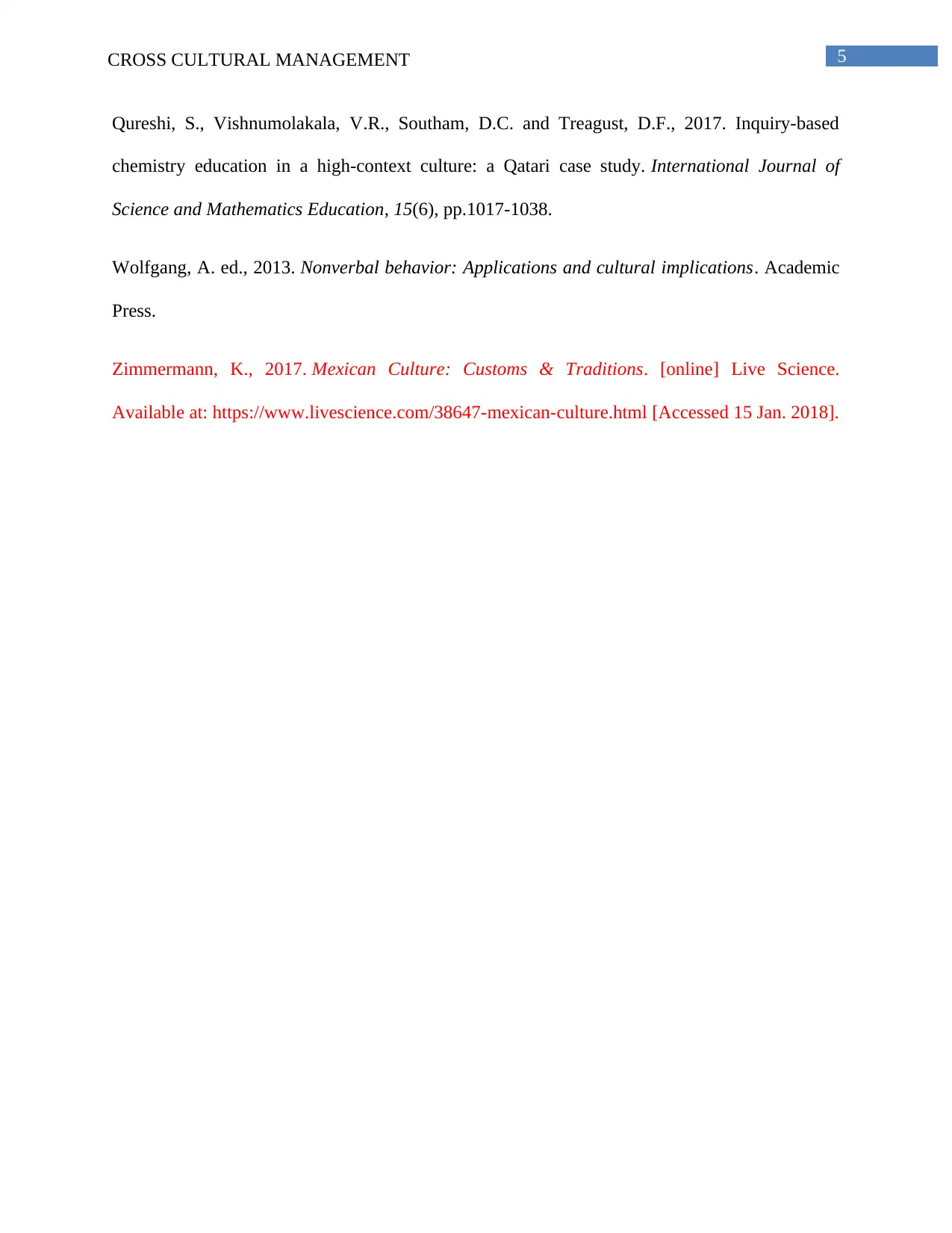
5CROSS CULTURAL MANAGEMENT
Qureshi, S., Vishnumolakala, V.R., Southam, D.C. and Treagust, D.F., 2017. Inquiry-based
chemistry education in a high-context culture: a Qatari case study. International Journal of
Science and Mathematics Education, 15(6), pp.1017-1038.
Wolfgang, A. ed., 2013. Nonverbal behavior: Applications and cultural implications. Academic
Press.
Zimmermann, K., 2017. Mexican Culture: Customs & Traditions. [online] Live Science.
Available at: https://www.livescience.com/38647-mexican-culture.html [Accessed 15 Jan. 2018].
Qureshi, S., Vishnumolakala, V.R., Southam, D.C. and Treagust, D.F., 2017. Inquiry-based
chemistry education in a high-context culture: a Qatari case study. International Journal of
Science and Mathematics Education, 15(6), pp.1017-1038.
Wolfgang, A. ed., 2013. Nonverbal behavior: Applications and cultural implications. Academic
Press.
Zimmermann, K., 2017. Mexican Culture: Customs & Traditions. [online] Live Science.
Available at: https://www.livescience.com/38647-mexican-culture.html [Accessed 15 Jan. 2018].
⊘ This is a preview!⊘
Do you want full access?
Subscribe today to unlock all pages.

Trusted by 1+ million students worldwide
1 out of 6
Related Documents
Your All-in-One AI-Powered Toolkit for Academic Success.
+13062052269
info@desklib.com
Available 24*7 on WhatsApp / Email
![[object Object]](/_next/static/media/star-bottom.7253800d.svg)
Unlock your academic potential
Copyright © 2020–2025 A2Z Services. All Rights Reserved. Developed and managed by ZUCOL.





